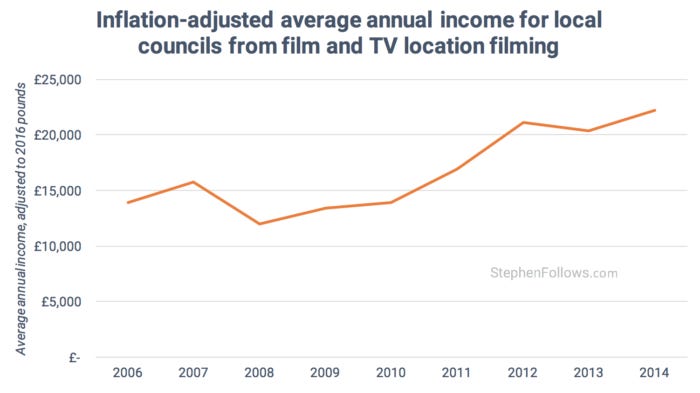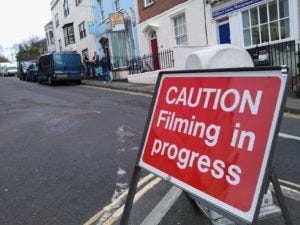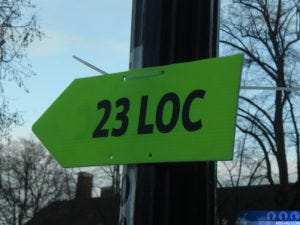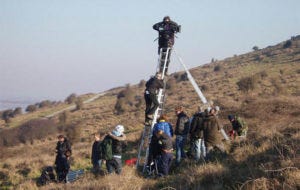A UK-wide investigation into the cost of location filming: Part 1

Today's article is the first in a multi-part series looking at the costs of location filming in the UK. I sent out almost 800 Freedom of Information requests in order to find out how much bodies such as local councils earn from location filming. Upcoming articles will focus on filming in museums, with the police and other related costs for shooting on location.
The Freedom of Information Act 2000 (FOI) allows the public to request information from public bodies and, save for a few exceptions, the bodies are required to answer. This is a wonderful piece of legislation as it empowers the public to hold their politicians and civil servants to account. Over the past few months I have made 793 Freedom of Information requests to all the UK public bodies I could find, including councils, police forces, museums, government departments and organisations. Some bodies are closed, some have merged, etc meaning that in the end I received answers from 563 bodies.
I asked them how much income they have received directly related to the shooting of film and television productions in their area over the past decade. I also asked them to explain the costs internally required to service such requests. The answers were all very different: some bodies were not able to answer every question, however, the vast majority did answer and from that I have built up a picture of how UK public bodies deal with the film and television industries. At the bottom of this article I have put more details of how this whole process worked.
The total amount local councils earn from location filming
In the ten years between 2006 and 2015, local councils in the UK earned over £23 million from location filming (well, at least £23,692,317 to be precise). The true figure is likely to be higher as some councils co-mingle their income so that it cannot split it apart to provide details of filming income, some don't keep records further back than six years, some refused to provide data (see below) and some did not provide income for 2015.
Since 2008, the average amount councils have received has increased each and every year. In order to show you the overall scale and increase, I have adjusted the income for inflation in the charts below.

Some councils could not provide income for the years before 2011 as they're only required to keep records for the current year and six previous years. Therefore, to get a more accurate level of scale I looked at the average amount councils received each year, taking into account only councils who provided data for each year.

Broken down by council
Below is a table containing details for the councils which provided data for the years 2006 to 2015, inclusive.
These figures are in GB pounds, are as provided and have not been adjusted for inflation. If an entry says '0' then this means that they did not receive any money that year from location filming, whereas 'n/a' means they did not provide data.
[table id=85 /]
If you find that your council is missing then it could be because they refused to provide data by using one of the FOI exclusions (see below).
As the table above shows, although councils can earn quite a bit from film productions, they cannot see it as a steady or reliable source of income. For example, the income for Liverpool City Council fluctuated significantly over a three year period - in 2013 it was £236,490, 2014 saw a huge drop to £71,828 and 2015 reached a whopping £463,275. Another example is Brighton and Hove City Council, who earn around £35,000 in a typical year, apart from in 2011 when they netted £320,269.
What services are they charging for?
Local councils provide a whole range of services for film and television productions, including...

Access to council land or buildings for film locations. Councils own a large number of buildings and sites which are attractive to filmmakers, such as town halls, libraries, town squares, beaches, woods and many other such locations. In some cases, local councils will charge productions for the right to film in such places.
Space for support vehicles and buildings. Location filming can involve an army of people and so productions need space nearby for their 'Unit Base'. This is typically made up of cars, lorries, trucks, buses, mobile toilets, dressing rooms, etc and is ideally situated in a large car park extremely close to the main location(s).
Road closures, parking dispensations and traffic management. Productions with many people, with famous names or involving complicated scenes will want to completely take over a location when they film. this can mean closing roads and re-routing traffic. They also often need a lot of parking, in council car parks and in temporarily commandeered on-road parking bays.
Advice and supervision. A council's film team will build up a knowledge base over time and so productions will often seek advice and support when they film in a place for the first time. Some councils charge for this, while others do not.
Calculating the cost of location filming
In conducting this research, one thing is very clear - there is no 'typical' cost of location filmmaking. Each area has its own way of calculating costs, its own rate card for common items and most boroughs adapt their costs based on the specific details of the production.
To give you a sense of the breadth and range of costs, here are a few examples...

Oxfordshire County Council is fairly typical in how they calculate their fees. They have a basic charge for film licences which varies according to the size of the production, plus additional charges depending on the specifics of the production. Their classifications are "Small" (1 – 5 crew) which is charged at £55 per day, "Medium" (6 – 11 crew) at £110 per day, "Large" (12 – 29 crew) at £320 per day and "Major features" (30 + crew) at £1,125 per day. This is a basic filming fee and more complicated requests will incur additional charges. For example, permission to use scaffolding or hoarding costs £110 for one month, 'Cherry pickers' are £75 for two days, and a crane is £200 for one day. I saw this method of calculation and rough scale of costs in a number of different councils.
The Royal Borough of Windsor and Maidenhead provides an hour of location advice for free, after which they charge £30 per hour.
Exeter City Council does not normally charge for film permits but will bill productions for use of its car parking facilities. In 2007, a production was charged £630 for the use of 70 spaces at £9 each.
The final figure charged will often be made up of a number of production-specific requirements. For example, in 2011 Eastbourne Borough Council charged a production £5,899.98 for one day's filming on Downland. A high figure but when you see what resources the production needed, it makes more sense - "Location fee - £650.00 (based on 3 hours filming and 7 hours prep) : Downland supervisor with 4x4 £25.00 per hour - £375.00 : Downland Support - £350 :Coastguard support for landing helicopter £25ph - £375 :Stewards £7.38 per hour - £2,536.56 (based on 2)".
Film productions can often ask for some pretty strange things in their pursuit of capturing what's in the script. In 2013 High Peak Borough Council charged a film production £1,800 for permission to shoot in a council cemetery for three days, plus a further £1,000 for "Grave Digging & Backfilling".
In 2014, Durham County Council charged the BBC £349 for turning street lighting on and off.
Free to shoot
A large number of councils do not charge filmmakers for shooting on council property and seem to actively encourage filmmakers to be in the area. This is due to the perceived role film and television productions can play in promoting the vicinity. Exeter City Council described it well:
Exeter City Council has a policy of being ‘film friendly’ by encouraging production companies to come here and film in public spaces or council-owned spaces free of charge. This is generally to our benefit as the filming can act as an advertisement for the area. Tourists often decide to visit the places they have seen on screen so the secondary benefits of filming can be large as we have found from the German Rosamunde Pilcher television drama filming.
The exception to the above concerns locations where they are one or more of the following: revenue-producing services e.g. car parks, for-hire attractions, open to the public and the filming prevents that public access or the use by film crews will cause some cost to the Council such as additional work by ECC employees, additional cleaning etc." And this is borne out in Exeter City Council's income records For example, in 2014 they fielded 35 enquires (assisting shoots for short films, dance films, corporate productions and primetime TV shows) and yet their only income throughout the year from filming was £27, which came from the suspension of two parking spaces for BBC's 'The One Show' unit base.
Some councils go very far down this road, maintaining a dedicated Film Unit but never seeking to recoup the costs of the unit from filmmakers. For example, Highlands of Scotland Film Commission (HFC) is a part of The Highland Council and provides "free and confidential information on locations, facilities and crew in the Highland area in order to increase the profile of the area to the media industry to attract inward investment". This means that their income from filmmakers over the past ten years was zero. But the unit's not cheap to run, costing £251,344 between April 2008 and March 2015.
The costs of servicing film productions
So far we have only looked at the raw costs charged to film productions, which ignores the fact that it can cost the councils money to facilitate filming. I also asked all my councils how much it cost them to manage location filming, although the answers were far less clear cut than with income.
Costs councils incur while facilitating filming can include...

Time taken in dealing with requests. The vast majority of councils do not have a dedicated Film Office and therefore found it hard to calculate the exact costs. In most cases, film permission and facilitation is managed by council employees who have other responsibilities and don't track their time. For example, Thurrock Council explained that they have created rules of thumb for how long it normally takes to manage the work associated with film permits, which for large productions includes "initial phone call" (10-20 mins), "email exchange" (30 mins-1hr), "Application review" (30 mins), "Internal liaison" (1 – 3 hrs) and "Location agreement" (30 mins).
Supervising locations. For larger projects, councils often send a member of staff to the set to provide access, supervise filming and to be on hand for unexpected problems. The pro rata cost of the member of staff is often added to the bill sent to the production company.
Lost income. When councils allow productions to take over locations or parking sites, they need to factor in the lost income they would normally receive from such sites. Councils don't seem to add this on a surcharge but instead have already factored it into the calculation of location fees.
Third party fees. Some councils use private companies to manage their location filming who charge for their services. The most widely used appears to be Film Fixer.
The FOI process
The process of submitting Freedom of Information (FOI) requests is relatively straightforward. The vast majority of organisations has a dedicated FOI email address (39% were just "foi@" and then the organisation's domain) and so I just emailed them with the same basic question. Most organisations acknowledge the request straight away and give you a date by which you can expect a full answer. Within 20 working days of receiving your application, the organisation is required to either fully answer the request, or provide the reasons they are refusing to answer some or all of your questions.
73% of public bodies who answered my request did so within the legal requirement of 20 working days. Some of the remaining 28% requested more time and kept me abreast of delays (as they are required to do), but many of the others didn't even mention the delay in their replies.

There are a number of reasons an organisation can cite refusing to answer an FOI request. The ones which I encountered in my research were...

It's too much work to answer - I did not have to pay anything for the FOI requests I made, however the organisations are allowed to consider the internal cost of collecting the information. If the internal cost exceeds £450 (£600 for central government), then the request can be refused. When I encountered this type of refusal I would refine my request; shortening the time period for which I was asking for information or removing entirely the request relating to the costs to the organisation of serving productions. This meant I was only asking for income for productions between 2011 and 2015.
Commercial interests - Section 43 of the FOI Act allows for refusal for information relating to "trade secrets and prejudice to commercial interests". A few organisations tried to use Section 43 to avoid answering but when pressed, they relented. I was asking for topline figures and not for any private information. Interestingly, there were a few organisations who I think ignored this concern, giving me full invoices and complete spreadsheets of accounts. Obviously I won't be publishing these full datasets. Camden Council tried to use this provision to refuse to answer but a few weeks ago I won an appeal, with the adjudicator noting "I don’t see how giving an overall figure – say per year – which doesn’t identify the number of productions etc. can be commercially confidential".
They don't hold the information - A few organisations initially claimed that they don't track income from film and television productions. What they meant was they do track all income (they are legally required to do so for six years, plus the current financial year) but they don't have a particular cost code for filming. Some organisations were fairly new (such as recently merged councils) and the records of the now-defunct bodies were not easily accessible. My favourite such response was basically "We've thrown them away". (Although they phrased it as "All our paper records relating to historic filming requests were destroyed as part of Directorate wide office decluttering move to paperless environment exercise in 2012/13").
After the organisation has replied, the person submitting the FOI is permitted to launch an appeal or request an internal review. I did this several times, once on the behest of someone within the organisation! After being provided with some figures, the FOI Officer within this organisation suggested I request an internal review as he suspected they had not included all income. His reason was that he wanted to "beat the [finance] department with a bit of a stick in the hope that they’ll pay more attention in the future".
Due to these exclusions, and because some organisations did not provide figures going back to all of the ten years requested, the figures I have should be seem as minimums, rather than complete figures. It is impossible to say that exactly £x has been paid to public bodies from the film and television industries. Instead, we have a good sense of scale and some useful anecdotal examples.
Notes on the cost of location filming
This project took almost six months and involved contacting almost 800 public bodies. Most bodies answered promptly and clearly but for a sizable minority I had to chase, cajole and pester in order to get answers. There are some notes and caveats which are worth considering with the research...

Small amounts of data are still outstanding - I am still awaiting answers from some bodies and in some cases I still have active appeals going through the system. One such example is Camden Council, who claimed that the amount they earned each year from location filming was a "trade secret". I appealed, and a few weeks ago the independent complaints investigations officer ruled in my favour. This means that I should expect figures from Camden Council in the coming months or so. Camden is a big, central London borough and so we can expect their figures to be of a roughly similar scale to that of Ealing (who earned £2.3 million 2006-15) or Wandsworth (£1.7 million 2006-15).
Most of the data relates to 2006 to 2014, inclusive - For charts showing changes over time I have only reported the figures up to (and including) 2014. This project has taken a while so for some of my earliest FOI requests the 2015 reporting year had not yet been completed, meaning that bodies were not able to give me 2015 figures.
Accounting practices vary - some councils have a dedicated Film Office and so we can be quite sure that the reported figures for that council reflect the true figure. However, others had to calculate the figures by liaising with many internal departments. Also, some councils mentioned that they excluded some aspects of their film work from the calculations. One such example is City of London Corporation, who did not include money earned via the Barbican Centre.
Calendar years vs tax years - My FOI requests specifically asked for the amounts to be broken down by calendar year. However, some organisations may have supplied data based around tax years, which run April to April, rather than January to December.
VAT - I believe that all the figures are exclusive of VAT, and in the few cases where figures were marked as including VAT I deducted it from the figures.
Inflation adjustment - Where I have adjusted for inflation I have done so on an annual basis as I was working with annual totals.
Epilogue

This research has been bigger than my normal projects, but for a film data geek like me it's been a fun one. It's nice to be able to measure something previously unmeasured, and to learn more about how this aspect of the film industry works.
I have come away proud of the UK's FOI and approach to open data within government. That said, there were a few alarming incidents I encountered. I saw warring departments requesting internal reviews on each other, have been sent far more detailed commercial data than I should and, most worryingly of all, highly personal details of someone's private life. This last incident involved the council officer sending me documents in error, which related to someone's adoption and upbringing. I pointed out the data breach and it was duly reported to the Data Protection Officer. The council emailed me a few times after that to check I had deleted the data. I had, but each time they emailed me they included the whole chain and attachments! This meant that as fast as I could delete this private data, they kept re-sending it to me! In all, this council sent me the person's private data four times.
I also learned more about how the public functions of the UK are structured, and named. Below are a list of eight council names, only one of which I have invented. Without Googling, can you guess which is fictitious?
Test Valley Borough Council
Vale of White Horse District Council
Clackmannanshire Council
Ribble Valley Borough Council
Bobbleton Borough Council
Oadby and Wigston Borough Council
Mole Valley District Council
Castle Morpeth Borough Council
Update on Camden Council
In the article above, I mentioned my battles with Camden Council to try to get to release the amount they have earned from film and television productions. I was successful in my appeal and so they have just released some of the requested information.
As I suspected, they do rather well from location filming, have earned almost £2 million is the past three years. The council said...
Please find below the total earned income through film and television productions. Be aware that these figures do not take into account all the costs borne by the council, but do include income from parking suspension, road closures and the hiring of sites; these figures do not include VAT. 2013-14 - £631,232.60 2014-15 - £547,443.66 2015-16 - £758,705.42



